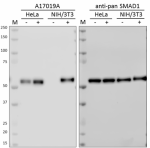- Clone
- A17019A (See other available formats)
- Regulatory Status
- RUO
- Other Names
- Mothers against decapentaplegic homolog 1, JV4-1, Mad-related protein 1
- Isotype
- Mouse IgG1, λ
- Ave. Rating
- Submit a Review
- Product Citations
- publications

-

Whole cell extracts (15 µg protein) from serum starved HeLa and NIH/3T3 cells untreated (-) or treated (+) with 100 ng/mL BMP-4 (Cat. No. 595202 and 595302) for 45 minutes were resolved on a 4-12% Bis-Tris gel, transferred to nitrocellulose and probed with 1.0 µg/mL (1:500 dilution) of purified anti-SMAD1 Phospho (Ser463/Ser465)/SMAD9 Phospho (Ser465/Ser467), clone A17019A, for 2 hours at room temperature. Proteins were visualized by chemiluminescence detection using HRP goat anti-mouse-IgG (Cat. No. 405306) at a 1:3000 dilution. Equal SMAD1 loading was confirmed by probing membranes with an anti-pan SMAD1 antibody. Lane M: Molecular Weight Marker.
| Cat # | Size | Price | Quantity Check Availability | Save | ||
|---|---|---|---|---|---|---|
| 610401 | 25 µg | $112 | ||||
| 610402 | 100 µg | $265 | ||||
SMAD1 and SMAD9 (SMAD8) are members of SMAD family, whose members play a critical role in signal transduction from the TGF-β receptor kinases. Activation of these receptors results in phosphorylation of SMAD1 and SMAD9 at a C-terminal SSXS motif (Ser463/Ser465 in SMAD1; Ser465/Ser467 in SMAD9), leading to dimerization with the coactivator SMAD4. The SMAD1-4 complex is translocated to the nucleus where it induces expression of target genes involved in differentiation, self-renewal, proliferation, and apoptosis.
Product DetailsProduct Details
- Verified Reactivity
- Mouse, Human
- Antibody Type
- Monoclonal
- Host Species
- Mouse
- Formulation
- Phosphate-buffered solution, pH 7.2, containing 0.09% sodium azide.
- Preparation
- The antibody was purified by affinity chromatography.
- Concentration
- 0.5 mg/ml
- Storage & Handling
- The antibody solution should be stored undiluted between 2°C and 8°C.
- Application
-
WB - Quality tested
- Recommended Usage
-
Each lot of this antibody is quality control tested by Western blotting. For Western blotting, the suggested use of this reagent is 0.25 - 1.0 µg per ml. It is recommended that the reagent be titrated for optimal performance for each application.
- Application Notes
-
Because the sequence of the synthetic phosphopeptide immunogen is completely conserved between SMAD1 and the corresponding residues in SMAD9 (Ser465/Ser467), this clone is predicted to recognize both phosphorylated proteins.
This clone is predicted to recognize rat SMAD1 Phospho (Ser463/Ser465) and SMAD9 Phospho (Ser465/Ser467) due to complete sequence homology between the immunizing peptide and each rat homolog. - RRID
-
AB_2801108 (BioLegend Cat. No. 610401)
AB_2801108 (BioLegend Cat. No. 610402)
Antigen Details
- Structure
- SMAD1 is a 465 amino acid protein with a predicted molecular weight of 52 kD. SMAD9 is 467 amino acid protein with a predicted molecular weight of 52 kD.
- Distribution
-
Ubiquitous expression/cytosolic and nuclear distribution
- Function
- Transcriptional activation/TGF- β signaling
- Interaction
- SMAD4, SMURF1, USP15, CBP, p300
- Biology Area
- Apoptosis/Tumor Suppressors/Cell Death, Cell Biology, Cell Proliferation and Viability, Signal Transduction, Transcription Factors
- Molecular Family
- Phospho-Proteins
- Antigen References
-
- Hoodless PA, et al. 1996. Cell. 85: 489-500.
- Whitman M. 1998. Genes Dev. 12: 2445-62.
- Alarcon C, et al. 2009. Cell. 139: 757-69.
- Gene ID
- 4086 View all products for this Gene ID 4093 View all products for this Gene ID
- UniProt
- View information about SMAD1 Phospho Ser463/Ser465 SMAD9 Phospho Ser465/Ser467 on UniProt.org
Related FAQs
Other Formats
View All SMAD1 Phospho SMAD9 Phospho Reagents Request Custom Conjugation| Description | Clone | Applications |
|---|---|---|
| Purified anti-SMAD1 Phospho (S463/S465)/SMAD9 (S465/S467) | A17019A | WB |
Compare Data Across All Formats
This data display is provided for general comparisons between formats.
Your actual data may vary due to variations in samples, target cells, instruments and their settings, staining conditions, and other factors.
If you need assistance with selecting the best format contact our expert technical support team.
-
Purified anti-SMAD1 Phospho (S463/S465)/SMAD9 (S465/S467)

Whole cell extracts (15 µg protein) from serum starved HeLa ...
 Login/Register
Login/Register 







Follow Us